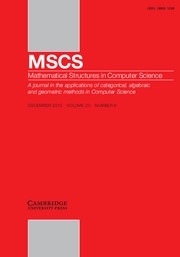Article contents
On universal computably enumerable prefix codes
Published online by Cambridge University Press: 01 February 2009
Abstract
We study computably enumerable (c.e.) prefix codes that are capable of coding all positive integers in an optimal way up to a fixed constant: these codes will be called universal. We prove various characterisations of these codes, including the following one: a c.e. prefix code is universal if and only if it contains the domain of a universal self-delimiting Turing machine. Finally, we study various properties of these codes from the points of view of computability, maximality and density.
- Type
- Paper
- Information
- Mathematical Structures in Computer Science , Volume 19 , Special Issue 1: Theory and Applications of Models of Computation (TAMC) , February 2009 , pp. 45 - 57
- Copyright
- Copyright © Cambridge University Press 2009
References
- 7
- Cited by


